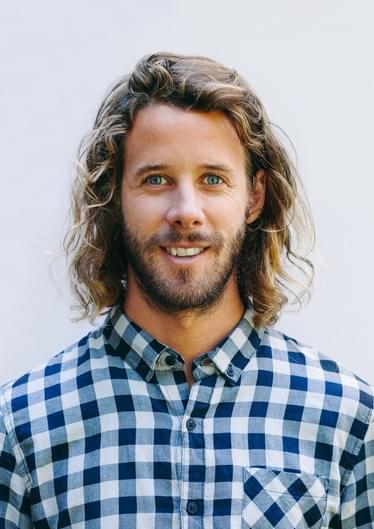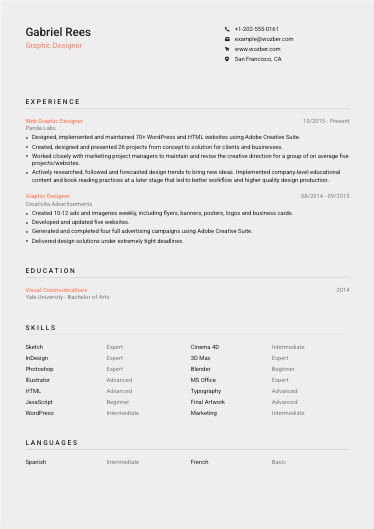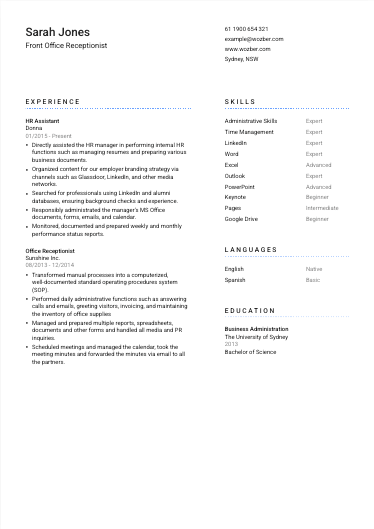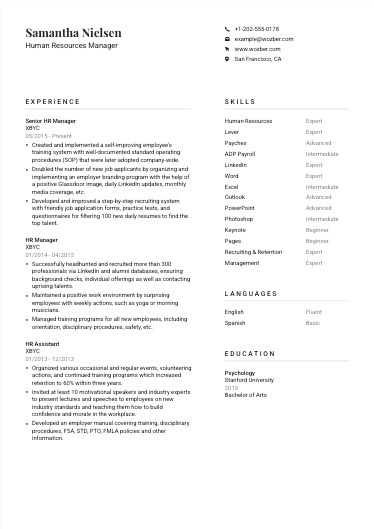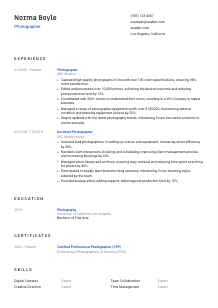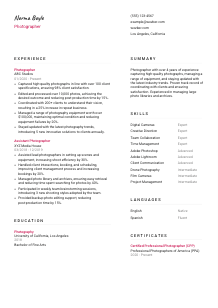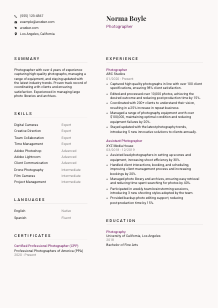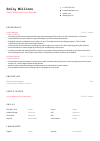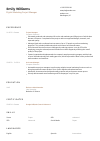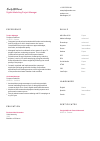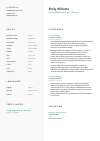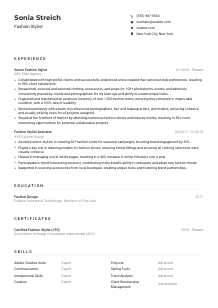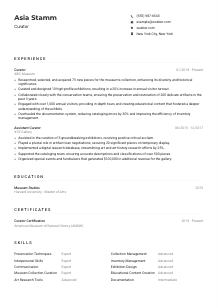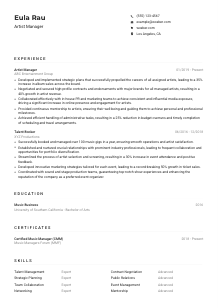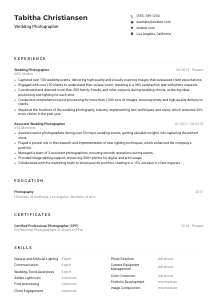Photographer CV Example
Capturing moments, but your CV feels out of focus? Zoom into this Photographer CV example, framed with Wozber free CV builder. Discover how effortlessly you can adjust your lens of expertise to align with job snapshots, making your career develop into picture-perfect opportunities!
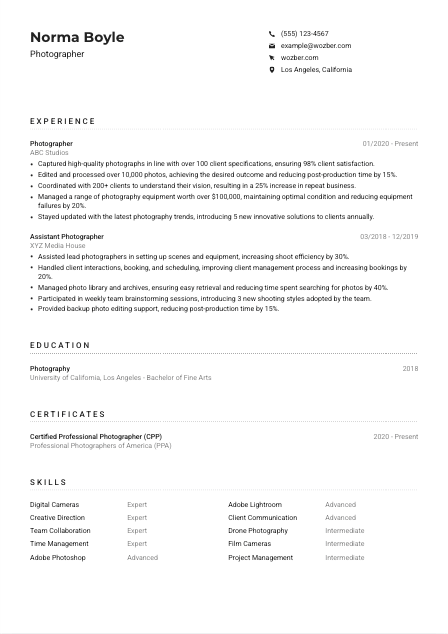
How to write a Photographer CV?
Welcome, aspiring Photographer! In a field where every detail and every shot matters, your CV must be a masterpiece reflecting your brilliance. It's more than a piece of paper; it's a gallery of your professional journey. Using the unparalleled tools of Wozber's free CV builder, including the ATS-compliant CV features, let's dive into how you can create a CV that not only captures your essence but also aligns perfectly with your dream Photographer role.
Ready to focus your career lens? Let's frame your experience and skills into a captivating narrative, making each element of your CV a testament to your talent.
Personal Details
Let's snap the first shot – your personal details. This is where you make an instant connection, providing a clear, sharp insight into who you are. Tailoring this section for a Photographer position requires an eye for detail and a flair for presentation.
1. Highlight Your Name
Think of your name as the title of your first solo exhibit; it should be prominently displayed. A professional font that's easy on the eyes will ensure your name catches the recruiter's attention from the get-go.
2. Frame Your Job Title
Just below your name, let the title "Photographer" shine. This not only shows your professional identity but also aligns your CV with the job you're aiming for, making it clear to the hiring manager that their search might just be over.
3. Provide the Essential Contacts
List your phone number and a professional email address. Ensuring there are no typos in this section is like double-checking your camera settings before a big shoot – crucial for avoiding missed opportunities.
4. Spotlight Your Location
Including "Los Angeles, California" not only shows you're in the right place but also aligns perfectly with one of the job's key requirements. It's like choosing the perfect backdrop for a portrait; it sets the scene for the rest of your CV.
5. Showcase Your Portfolio
If applicable, adding a link to your professional profile or personal photography website is like opening the door to your gallery. It offers a tangible glimpse into your skill set and creativity, inviting the hiring manager into your world.
Takeaway
Your personal details are the first frame of your professional portrait. Done right, they not only introduce you but also align fundamentally with the job you're applying for. Keep it professional, precise, and in tune with the Photographer position. Think of it as setting the stage for the masterpiece that is your CV.





Experience
In the world of photography, your experience can speak volumes. This section is your portfolio within a portfolio, showcasing your journey through the lenses and locations that have defined your career so far.
- Captured high‑quality photographs in line with over 100 client specifications, ensuring 98% client satisfaction.
- Edited and processed over 10,000 photos, achieving the desired outcome and reducing post‑production time by 15%.
- Coordinated with 200+ clients to understand their vision, resulting in a 25% increase in repeat business.
- Managed a range of photography equipment worth over $100,000, maintaining optimal condition and reducing equipment failures by 20%.
- Stayed updated with the latest photography trends, introducing 5 new innovative solutions to clients annually.
- Assisted lead photographers in setting up scenes and equipment, increasing shoot efficiency by 30%.
- Handled client interactions, booking, and scheduling, improving client management process and increasing bookings by 20%.
- Managed photo library and archives, ensuring easy retrieval and reducing time spent searching for photos by 40%.
- Participated in weekly team brainstorming sessions, introducing 3 new shooting styles adopted by the team.
- Provided backup photo editing support, reducing post‑production time by 15%.
1. Analyze the Job Description
Begin by closely examining the job description. Identify the requirements like "capture high-quality photographs" or "manage and maintain photography equipment," and prepare to reflect these in your CV, showing you're the perfect shot they've been aiming for.
2. Compose with Clarity
Structure your experience in a clear, chronological order, starting with your most recent role. For each position, include your title, the company name, and your tenure there, creating a clear timeline of your career.
3. Focus on Achievements
For each role, compile bullet points highlighting your accomplishments and responsibilities that resonate with the job specifications. Enhancing 10,000 photos, managing $100,000 worth of equipment – these achievements put into perspective the depth of your experience.
4. Quantify Your Impact
Whenever possible, quantify your accomplishments. Saying you boosted client satisfaction to 98% or increased repeat business by 25% adds weight to your claims, giving them the depth and perspective that numbers can provide.
5. Capture Relevant Details
Tailor your experiences to the job at hand. While your stint as a landscape photographer might be fascinating, if it's not directly relevant, focus instead on the engagements that align with the job's requirements, ensuring every detail contributes to your story.
Takeaway
Crafting a compelling experience section is like curating a gallery showing; each piece should have its purpose, contributing to the narrative you're trying to convey. Frame your history in a way that highlights your qualifications, resonates with the job at hand, and demonstrates why you're the ideal candidate for the role.
Education
In photography, education can provide a crucial technical base, imparting skills that refine your natural talent. Let's zoom in on how to structure this essential section in the backdrop of your chosen career path.
1. Identify Essential Education
Start by pinpointing the key education criteria the job listing specifies. In instances where a specific requirement isn't mentioned, like in our Photographer example, your degree in Photography from the University of California, Los Angeles serves as a testament to your foundational knowledge.
2. Layout the Basics
Keep this section straightforward and focused. Detail your field of study, the degree obtained, the institution's name, and your graduation date. This clarity lays a solid foundation for your professional expertise.
3. Focus on Relevance
Align your educational accomplishments with the job's requirements. A Bachelor of Fine Arts in Photography directly resonates with the expertise sought, reinforcing your suitability for the position.
4. Highlight Pertinent Courses
If specific courses or projects directly align with the job's nature, don't hesitate to mention them. This could spotlight specialized skills or knowledge, adding another layer of relevance to your CV.
5. Showcase Additional Achievements
Include honors, clubs, or significant projects, especially if they're related to photography. This could offer a more comprehensive view of your background, though remember to assess their relevance based on the job level you're targeting.
Takeaway
Your education section is a reflection of your technical proficiency and dedication. It's crucial to present it in a way that resonates with what the employer is seeking. By aligning your educational background with the job's requirements, you further establish your candidacy as well-suited for the Photographer role.
Certificates
In a field as ever-evolving as photography, certificates are badges of your commitment to growth and excellence. Let's focus on framing these achievements in a way that underscores your expertise and passion.
1. Identify Key Certifications
Revisit the job description to pinpoint certificates like the "Certified Professional Photographer (CPP)" designation that directly align with the role's requirements. This demonstrates your dedication to your craft and your fit for the position.
2. Selectively Highlight Your Certificates
Choose to list certificates that underscore your qualifications for the role. In this case, the CPP is not only preferred but showcases a recognized standard of excellence in the field of photography.
3. Detail with Dates
If your certification is current, as with the CPP designation marked "2020 - Present," it reinforces the relevance of your skills and knowledge in the rapidly changing photography landscape.
4. Commit to Continuous Learning
The world of photography never stands still, and neither should your education. Regularly seeking out new certificates or courses signals your commitment to staying at the peak of your profession.
Takeaway
Your certificates are testaments to your journey of continuous improvement and specialization. By carefully selecting and presenting certifications that align with the job's requirements, you not only meet the baseline qualifications but also demonstrate an above-and-beyond commitment to your craft.
Skills
Just as a photographer selects the perfect lens for the shot, so too must you carefully choose the skills to feature on your CV. These are the tools of your trade, the core competencies that make you a standout candidate.
1. Identify Essential Skills
Examine the job posting for explicit and implicit skill requirements. Skills like "digital and film cameras proficiency," "advanced knowledge of photo editing software," and "strong interpersonal skills" should find a place in your CV, reflecting a one-to-one match with the employer's needs.
2. Match and List Relevant Skills
Align your own skills with those listed in the job description. It's critical to include both hard and soft skills, showcasing not only your technical prowess with cameras and editing software but also your ability to communicate effectively with clients.
3. Organize and Prioritize
Keep your skills section concise and targeted. List the most relevant skills first, making sure they are easy to find and understand. Remember, this section is a highlight reel of your capabilities, so make every entry count.
Takeaway
Your skills section is the core of your professional identity, a clear display of what makes you the ideal candidate for the Photographer role. Craft it with care, select each skill with purpose, and always aim to mirror the job description's requirements. This is your opportunity to shine and show off the tools in your professional photographer's bag.
Languages
In today's interconnected world, language skills can be an incredible asset, opening doors to diverse clients and projects. Let's capture how you can showcase these invaluable assets in your CV.
1. Check the Job's Language Requirements
First, identify any specific language requirements or preferences mentioned in the job listing. For our Photographer role, "fluent conversational English" is a must. This skill should be prominently displayed, assuring employers of your communication capabilities.
2. Prioritize Necessary Languages
Highlight the languages essential for the job at the top of your section, marking your proficiency level. For instance, marking "English: Native" directly addresses one of the job's key requirements.
3. List Additional Language Skills
If you're fluent in more languages, include them too. Each additional language is a door to new possibilities and showcases your ability to engage with a broader range of clients and subjects.
4. Be Honest About Your Proficiency
Clearly describe your level of proficiency with each language. Whether you're native, fluent, intermediate, or basic, being transparent about your abilities ensures clear communication and sets the right expectations.
5. Reflect on the Role's Scope
Consider how your linguistic abilities align with the job's requirements and opportunities. In a city as diverse as Los Angeles, additional languages besides English could significantly broaden your clientele and project scope.
Takeaway
Your language skills aren't just personal attributes; they're professional tools that enhance your repertoire. They signify your ability to connect across cultures and contexts, adding depth to your CV. Flaunt your linguistic talents with confidence, understanding that they open up a world of photographic opportunities.
Summary
The summary section is your CV's opening statement, a brief yet powerful narrative that encapsulates your professional identity. Let's perfect this opening shot, making it as compelling as your photography.
1. Grasp the Job's Core
Begin by absorbing the essence of the job description. Understand what the role demands and how your unique blend of skills, experience, and personality makes you the ideal candidate.
2. Start with a Strong Introduction
Introduce yourself with a statement that reflects your professional standing and aspirations. "Photographer with over 4 years of capturing high-quality photographs..." immediately showcases your experience and aligns with the job requirements.
3. Highlight Your Unique Offerings
Mention your key skills and notable achievements, especially those that fulfill the job's requirements. Your expertise in managing photo libraries, achieving client satisfaction, and staying ahead of photography trends tells your story in a way that resonates with potential employers.
4. Keep It Precise
Like the perfect photograph, your summary should be clear, focused, and devoid of unnecessary elements. Aim for 3-5 lines that capture the essence of your professional identity, enticing the reader to delve deeper into your CV.
Takeaway
Think of the summary as the lens through which recruiters see your candidacy. Craft it with the same care and attention you would give to framing a photograph. By aligning it with the job's requirements, you're instantly establishing yourself as a compelling candidate, ready to capture the moment and excel in the role.
Launching Your Photographer Journey
Congratulations on completing this workshop! You've now got the toolkit to craft a CV that not only matches the job's criteria but captures the very essence of your talent as a Photographer. Remember, your CV is the first exhibition of your work that hiring managers will see. Use the ATS-friendly CV templates and ATS CV scanner available in Wozber's free CV builder to ensure that your CV is as technically sound as it is creatively compelling.
Now, take these tools, apply them with care, and step into the light. Your next great role is just around the corner!

- Minimum of 3 years of professional photography experience.
- Proficiency in using both digital and film cameras, as well as drone photography.
- Advanced knowledge of photo editing software such as Adobe Photoshop and Lightroom.
- Strong interpersonal and communication skills to effectively work with clients and subjects.
- Possession of relevant photography certification, such as the Certified Professional Photographer (CPP) designation.
- Must have the ability to converse fluently in English.
- Must be located in or willing to relocate to Los Angeles, California.
- Capture high-quality photographs in line with client or project specifications.
- Edit, retouch, and process photos to achieve the desired outcome.
- Coordinate with clients to understand their vision and provide expert advice on styling, setting, and other elements.
- Manage and maintain photography equipment, ensuring it's in optimal condition for shoots.
- Stay updated with the latest photography trends, techniques, and technologies to offer innovative solutions to clients.
